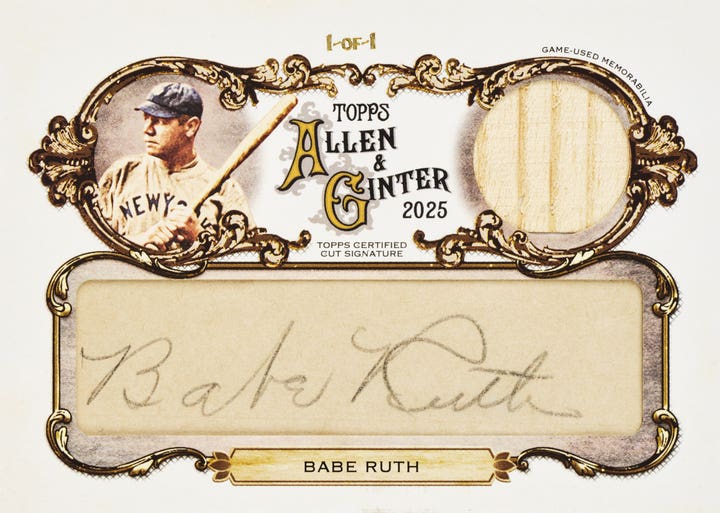Honus Wagner
The 1911 T201 Mecca Baseball set gives collectors a few legs up
By Doug Koztoski
Whether stealing bases or legging out some hits that turned into doubles, triples or inside-the-park home runs, Ty Cobb and Sam Crawford made for quite a duo in the same Detroit Tigers’ batting order for many years beginning in the early 1900s.
Over time the teammates became rivals, often not speaking to each other. Yet, both outfielders went on to Hall of Fame careers with Cobb setting many records, some that still stand, such as the highest lifetime batting average in MLB history (.366 or .367, depending on the source).
Crawford, meantime, holds the lifetime mark for triples, at 309 (or 312, again, sources differ) with Cobb a close second. Although the top two all-time triples leaders will likely never be seriously challenged in that department, it is in a certain doubles category that they will also forever be truly connected: the 1911 Mecca Double Folders set, where they share the same card.
The 50-card Double Folders, with the T201 catalog designation, includes dozens of collectors who are listed on the PSA Set Registry’s Current Finest rankings for the issue, with Larry Mayer (#5), Joel Tschantz (#11) and the brothers-in-law tandem of Mark Chlebeck and Todd Kottke (#4) among them.
Mayer puts his T201 set among his all-time favorites, “now equaled by only the N172 Old Judge and maybe the T3 Turkey sets” in his eyes. Tschantz felt “the T201s would be a nice addition to my tobacco card collection” after finishing the T205 and T206s (minus the Big 4) sets. Chlebeck noted he and Kottke “had great fun putting the set together.”
What attracts them so much to the offering? They like the overall look of the fronts, or as Mayer put it: “the beautiful hand-painted pastel-hued full length player portraits” coupled with the “impressionistic background extending to the card’s edge.” The backs, meanwhile, deliver “an upside-down 1/3 size head-to-knees portrait of a different player from the same team above their 1910 batting and fielding statistics.” Chlebeck noted the T201s helped pioneer displaying statistics on cards.
Of course, the innovative design with the intentional hinge, or fold, always gets its due. The “cleverness,” of the set, Mayer said, “is that when the small portrait of the player on the back is folded over the front, then the lower legs and feet of the player on the front matchup with the upper legs and body of the player on the back to create a new portrait of the second player.”
And then, without Mayer knowing this article contained a Crawford/Cobb angle he said, “I can imagine a father handing his son a (T201) card of “Wahoo Sam” Crawford stretching for a ball while straddling a base and having the kid fold over the card to find Ty Cobb crossing the same base.” How cool would that have been?
Seeing stars
The Crawford/Cobb combo, the set’s key, is one of a handful of two future Hall of Famers on the same T201, along with Roger Bresnahan/Miller Huggins, Eddie Collins/Frank “Home Run” Baker, and John Evers/Frank Chance.
All of the collectors mentioned above have their favorites in the set, for sure, but a couple that cropped up often for this article are Cobb/Crawford (no surprise) and Cleveland star Napoleon Lajoie.
“You’ve got to love the Cobb card,” Mayer said, “where his 1910 stats show him with a .385 average and 65 stolen bases, or the Lajoie where his 1910 stats show his .384 average.”
In 1911 Lajoie was liked so much in Cleveland they had been nicknaming the team the Naps (short for Napoleons) for a few seasons.
Other superstars in Double Folder duds include Walter Johnson, Tris Speaker and Christy Mathewson, whose name is misspelled with two “Ts” on his card front.
Sadly, the set does not include the likes of Cy Young, in his last MLB season in 1911, “Shoeless” Joe Jackson, who was playing in his first full campaign, or Pittsburgh Pirates star Honus Wagner.
A couple of other players of some note, mind you a sour one for many, that attract strong attention in the hinged collection are Ed Cicotte, of 1919 Black Sox infamy, and Hal Chase, who also had some gambling issues that eventually chased him from the diamond, as well.
Locating T201s is normally not a big issue, unless you want them in higher grades. Tschantz said the Lord/Dougherty card “is typically the most difficult for collectors to find.”
Some say the story on the Lord/Dougherty being “short-printed” is that it was only put in the packs at Mecca’s Factory 649 facility, not at the Factory 30 location. The factory number is printed at the bottom of the card backs.
Chlebeck said higher grades for Cicotte and the Killian/Fitzpatrick also offer strong challenges. Plus, the Cubs’ Kling/Cole combo makes many “tough” lists, too.
Heading for home
Mayer noted the Double Folders set “gets far less attention than it deserves and is more affordable than its more common single-player set counterparts.” One example he gave compared a PSA 8 T206 Cobb with a red background that brought $54,000 at a recent Goldin auction.
“There are 19 Cobbs with red backgrounds in PSA 8, with two higher graded. Two PSA 8 T201 Cobbs fetched less than $10,000 in each of its last two public sales, despite the fact that it has a (PSA) population of just five, with none graded higher. That seems like an incredible bargain.”
In that vein, Chlebeck added that he and Kottke “were able to find and purchase the set without too much difficulty and (it was) much less expensive than expected.”
The T201 issue certainly has a strong foothold in not only tobacco-era card sets, but those issued prior to 1950 in general, the offering’s dozens of collectors on the Set Registry perhaps reflect just a small representation of its popularity.
Tschantz feels the set is very underrated and thinks it has “great potential.” Perhaps he put it best when he predicted the Double Folders’ future: “I think as people complete their more popular “T” (tobacco) sets, you will see more demand for the T201s and the T202s. When collectors realize just how few of these cards exist compared to the traditional “T” sets, I think demand (and price) will rise.”
On a side note, after Cobb died in 1961 a reporter found hundreds of letters in the home of “The Georgia Peach,” some that Cobb had written lobbying for Crawford’s inclusion in The Hall of Fame (which happened in 1957). Not until after Cobb passed away did Crawford find out about his former teammate’s letter-writing efforts. So, one could say that ultimately, like in the T201 set, Cobb had Crawford’s back.
Doug Koztoski is a frequent contributor to Sports Collectors Digest. He can be contacted at dkoz3000@gmail.com.








